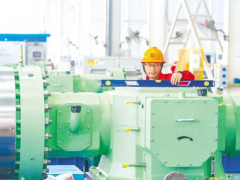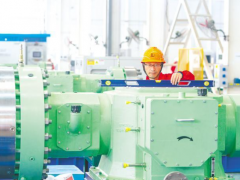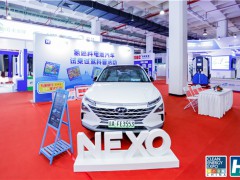美國萊斯大學的科學家們發(fā)明了一種將氨轉化為氫的新方法
這項研究遵循政府和行業(yè)投資,為不會導致溫室效應的無碳液氨燃料創(chuàng)建基礎設施和市場
氨氣仍然是相當有害的氣體,但它的點火和快速燃燒是可以忽略不計的
據(jù)油價網報道,美國萊斯大學(Rice University)的科學家們日前發(fā)明了一種光活化催化劑,可以只使用廉價的原材料就能有效地將氨氣轉化為清潔燃燒的氫氣。這個設計是一種光激活納米材料,可將氨氣轉化為清潔燃燒的氫氣。
這項工作是萊斯大學納米光子學實驗室、Syzygy等離子體子學公司和普林斯頓大學Andlinger能源與環(huán)境中心的一個合作項目。該研究報告已發(fā)表在《科學》雜志上。
在這項研究啟動之前,美國政府和行業(yè)投資建立了基礎設施和市場,以生產不會導致溫室效應的無碳液態(tài)氨燃料。液態(tài)氨易于運輸,每個分子含有1個氮原子和3個氫原子,能量巨大。新的催化劑將這些分子分解成氫氣(一種清潔的燃料)和氮氣(地球大氣中最大的成分)。與傳統(tǒng)催化劑不同的是,它不需要熱量。相反,它從光中收集能量,無論是陽光還是節(jié)能的LED。
化學反應的速度通常隨著溫度的升高而加快,一個多世紀以來,化學品生產商一直在利用這一點,在工業(yè)規(guī)模上加熱。燃燒化石燃料將大型反應容器的溫度提高數(shù)百或數(shù)千度會產生巨大的碳足跡。化學品生產商每年還在熱催化劑上花費數(shù)十億美元,這種材料不發(fā)生反應,但在強烈加熱下會加速反應。
這項研究的合著者、萊斯大學的內奧米·哈拉斯指出:“像鐵這樣的過渡金屬通常是較差的熱催化劑,這項工作表明它們可以成為高效的等離子體光催化劑。這也證明了光催化可以用廉價的LED光子源有效地進行。”
萊斯大學研究報告的合著者彼得·諾德蘭德補充說:“這一發(fā)現(xiàn)為可持續(xù)的、低成本的氫氣鋪平了道路,這種氫氣可以在當?shù)厣a,而不是在大型集中式工廠生產。”
最好的熱催化劑是由鉑和相關貴金屬如鈀、銠和釕制成的。 哈拉斯和諾德蘭德花了數(shù)年時間開發(fā)光激活或等離子體金屬納米顆粒。 其中最好的也通常是由銀和金等貴金屬制成的。
2011年,他們發(fā)現(xiàn)了等離子體粒子,這種粒子會釋放出短命的高能電子,稱為“熱載流子”。2016年,他們發(fā)現(xiàn)熱載流子發(fā)電機可以與催化粒子結合,產生混合“天線反應器”,其中一部分從光中收集能量,另一部分利用能量以外科手術般的精度驅動化學反應。
哈拉斯、諾德蘭德、他們的學生和合作者多年來一直致力于為天線反應器的能量收集部分和反應加速部分尋找非貴金屬替代品。這項新研究是這項工作的高潮。在這篇文章中,哈拉斯、諾德倫德、萊斯大學校友侯賽因· 羅巴塔茲、普林斯頓大學工程師兼物理化學家艾米麗·卡特等人展示了由銅和鐵制成的天線反應器粒子在轉化氨氣方面非常高效。粒子的銅能量收集部分從可見光中獲取能量。
Robatjazi是哈拉斯研究小組的博士校友,現(xiàn)在是總部位于休斯敦的光催化劑研發(fā)公司Syzygy Plasmonics的首席科學家,他解釋說,在沒有光的情況下,銅-鐵催化劑表現(xiàn)出比銅-釕催化劑低300倍的反應活性,這并不奇怪,因為釕是一種反應更好的熱催化劑。在光照下,銅-鐵的效率和反應活性與銅-釕的效率和反應活性相似并具有可比性。
Syzygy Plasmonics公司已經獲得了萊斯大學的天線反應器技術的許可,該研究還包括在該公司的商用LED動力反應器中對催化劑進行大規(guī)模測試。在萊斯大學的實驗室測試中,用激光照亮了銅鐵催化劑。Syzygy Plasmonics公司的測試表明,催化劑在LED照明和比實驗室設置大500倍的規(guī)模下仍然保持其效率。
哈拉斯說:“這是科學文獻中第一份表明LED光催化可以從氨氣中產生克級數(shù)量的氫氣的報告。”“這為完全取代等離子體光催化中的貴金屬打開了大門。”
卡特補充說:“鑒于等離子體天線反應器光催化劑在顯著減少化學部門碳排放方面的潛力,它們值得進一步研究。”“這些結果是一個很好的激勵因素。他們認為,充足的金屬的其他組合很可能被用作廣泛化學反應的低成本催化劑。”
有人可能會認為,氫氣運輸和儲存解決方案的大門很快就會打開。對于大多數(shù)人來說,氫氣作為運輸燃料,便攜性和安全性更高。
氨氣仍然是相當有害的氣體,但它的點火和快速燃燒可以忽略不計。氨氣也是氫氣的非加壓載體。氨氣確實有一種非常強烈的氣味。總而言之,作為一種實用的氫氣載體,它是相當不錯的。
還有一些問題,比如需要多少光能來驅動一輛汽車。擴大測試正在進行中。然后,人們會想知道如何消除氮氣,以及以某種方式將氮氣或雙氮分子排放回大氣中是否會造成能源成本。
李峻 編譯自 油價網
原文如下:
Scientist Invent New Way To Convert Ammonia Into Hydrogen
· Rice University scientists have invented a new way to convert ammonia into hydrogen.
· The research follows government and industry investment to create infrastructure and markets for carbon-free liquid ammonia fuel that will not contribute to greenhouse warming.
· Ammonia is still fairly noxious, but its ignition and rapid combustion are negligible
Rice University scientists have invented a light-activated catalyst that efficiently converts ammonia into clean-burning hydrogen using only inexpensive raw materials. The design is a light-activated nanomaterial to convert the ammonia into clean-burning hydrogen fuel.
The effort is a collaborative project from Rice’s Laboratory for Nanophotonics, Syzygy Plasmonics Inc. and Princeton University’s Andlinger Center for Energy and the Environment. The research report has been published in the journal Science.
The research follows government and industry investment to create infrastructure and markets for carbon-free liquid ammonia fuel that will not contribute to greenhouse warming. Liquid ammonia is easy to transport and packs a lot of energy, with one nitrogen and three hydrogen atoms per molecule. The new catalyst breaks those molecules into hydrogen gas, a clean-burning fuel, and nitrogen gas, the largest component of Earth’s atmosphere. And unlike traditional catalysts, it doesn’t require heat. Instead, it harvests energy from light, either sunlight or energy-stingy LEDs.
The pace of chemical reactions typically increases with temperature, and chemical producers have capitalized on this for more than a century by applying heat on an industrial scale. The burning of fossil fuels to raise the temperature of large reaction vessels by hundreds or thousands of degrees results in an enormous carbon footprint. Chemical producers also spend billions of dollars each year on thermocatalysts – materials that don’t react but further speed reactions under intense heating.
Study co-author Naomi Halas of Rice noted, “Transition metals like iron are typically poor thermocatalysts, This work shows they can be efficient plasmonic photocatalysts. It also demonstrates that photocatalysis can be efficiently performed with inexpensive LED photon sources.”
Rice co-author Peter Nordlander added, “This discovery paves the way for sustainable, low-cost hydrogen that could be produced locally rather than in massive centralized plants.”
The best thermocatalysts are made from platinum and related precious metals like palladium, rhodium and ruthenium. Halas and Nordlander spent years developing light-activated, or plasmonic, metal nanoparticles. The best of these are also typically made with precious metals like silver and gold.
Following their 2011 discovery of plasmonic particles that give off short-lived, high-energy electrons called “hot carriers,” they discovered in 2016 that hot-carrier generators could be married with catalytic particles to produce hybrid “antenna-reactors,” where one part harvested energy from light and the other part used the energy to drive chemical reactions with surgical precision.
Halas, Nordlander, their students and collaborators have worked for years to find non-precious metal alternatives for both the energy-harvesting and reaction-speeding halves of antenna reactors. The new study is a culmination of that work. In it, Halas, Nordlander, Rice alumnus Hossein Robatjazi, Princeton engineer and physical chemist Emily Carter, and others show that antenna-reactor particles made of copper and iron are highly efficient at converting ammonia. The copper, energy-harvesting piece of the particles captures energy from visible light.
Robatjazi, a Ph.D. alumnus from Halas’ research group who is now chief scientist at Houston-based Syzygy Plasmonics explained, “In the absence of light, the copper-iron catalyst exhibited about 300 times lower reactivity than copper-ruthenium catalysts, which is not surprising given that ruthenium is a better thermocatalyst for this reaction. Under illumination, the copper-iron showed efficiencies and reactivities that were similar to and comparable with those of copper-ruthenium.
Syzygy has licensed Rice’s antenna-reactor technology, and the study included scaled-up tests of the catalyst in the company’s commercially available, LED-powered reactors. In laboratory tests at Rice, the copper-iron catalysts had been illuminated with lasers. The Syzygy tests showed the catalysts retained their efficiency under LED illumination and at a scale 500 times larger than lab setup.
“This is the first report in the scientific literature to show that photocatalysis with LEDs can produce gram-scale quantities of hydrogen gas from ammonia,” Halas said. “This opens the door to entirely replace precious metals in plasmonic photocatalysis.”
“Given their potential for significantly reducing chemical sector carbon emissions, plasmonic antenna-reactor photocatalysts are worthy of further study,” Carter added. “These results are a great motivator. They suggest it is likely that other combinations of abundant metals could be used as cost-effective catalysts for a wide range of chemical reactions.”
One might think the door could be open soon for the hydrogen transport and storage solution. For most folks looking at hydrogen for a transport fuel, portability, and lots more safety, ammonia containment offers a huge leap forward.
Ammonia is still fairly noxious, but its ignition and rapid combustion are negligible. It is also a non pressurized carrier for hydrogen. It does have a very strong odor, giving some warning of its escape. All in all, as a practical hydrogen carrier, its pretty good.
There are some questions like just how much light energy is needed to say, power an automobile. The scale up testing is underway. Then one wonders how to dispense with the nitrogen and if there is an energy cost as well to venting somehow a N2 or di-nitrogen molecule back into the atmosphere harmlessly.
We’re going to be watching for more on this.
免責聲明:本網轉載自其它媒體的文章及圖片,目的在于弘揚石化精神,傳遞更多石化信息,宣傳國家石化產業(yè)政策,展示國家石化產業(yè)形象,參與國際石化產業(yè)輿論競爭,提高國際石化產業(yè)話語權,并不代表本網贊同其觀點和對其真實性負責,在此我們謹向原作者和原媒體致以崇高敬意。如果您認為本站文章及圖片侵犯了您的版權,請與我們聯(lián)系,我們將第一時間刪除。







